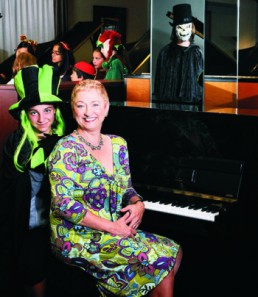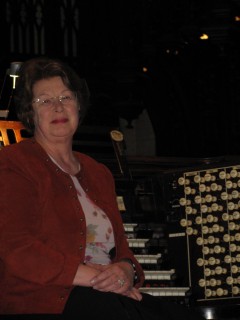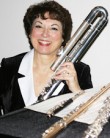Ten Pianos, and a Pianist
 One of the more unusual concerts of the month – perhaps of the season – is the Halloween “monster concert” on October 31, organized by pianist and educator Mary Kenedi. “Monster concert,” for the record, is a term referring to a concert performed on ten pianos by as few as ten and as many as 30 pianists.
One of the more unusual concerts of the month – perhaps of the season – is the Halloween “monster concert” on October 31, organized by pianist and educator Mary Kenedi. “Monster concert,” for the record, is a term referring to a concert performed on ten pianos by as few as ten and as many as 30 pianists.
The idea goes back well over a century and a half, when the famous Austrian pianist, composer and educator Carl Czerny organized the first monster concert ever in the 1830s to raise money to help the victims of the flooding of the Danube River. More recently, Kenedi herself performed in a monster concert in Toronto conducted by William Shookhoff, who himself once organized, at Rosalyn Carter’s (Jimmy Carter’s wife) request, a monster concert at the White House.
As this appears to be one of Shookhoff’s specialties, Kenedi has enlisted him as the conductor of her concert on October 31. Among other performers joining Kenedi for the occasion are composers Abigail Richardson, Gary Kulesha and Larissa Kuzmenko, as well as piano teachers from Kenedi’s North Toronto Institute of Music and 30 of their students, who will play, three to a piano, the prelude to Bizet’s Carmen and three songs from the Harry Potter movies, arranged by a North Toronto Institute student.
All the performers will wear costumes, and Cadbury has donated the content of loot bags to be given out to children attending the event.
To add some contrast, Saint-Saëns’ Carnival of the Animals will be played by two pianists on two pianos, and Kenedi will perform Liszt’s Mephisto Waltz. The concert will take place at Massey Hall between 3:00 and 5:00 on Halloween, so there will be no conflicts with the important business of trick-or-treating.
Minsoo Sohn
 A charming and somewhat off-the-beaten-track venue is the lobby of Classical 96 FM on Queen St. E. It is not large – perhaps 30 feet square, two stories high, with a long staircase leading up to a mezzanine on the floor above. Beneath the stairs sits a small grand piano, which was the focus of a noon-hour concert I attended recently. The performer was the Korean-born, 33-year-old pianist and Honens First Prize Laureate (2006) Minsoo Sohn, who will be back in Toronto on October 3 for his Glenn Gould Studio debut recital and again on January 14 to perform with Canadian cellist, Rachel Mercer, for Music Toronto.
A charming and somewhat off-the-beaten-track venue is the lobby of Classical 96 FM on Queen St. E. It is not large – perhaps 30 feet square, two stories high, with a long staircase leading up to a mezzanine on the floor above. Beneath the stairs sits a small grand piano, which was the focus of a noon-hour concert I attended recently. The performer was the Korean-born, 33-year-old pianist and Honens First Prize Laureate (2006) Minsoo Sohn, who will be back in Toronto on October 3 for his Glenn Gould Studio debut recital and again on January 14 to perform with Canadian cellist, Rachel Mercer, for Music Toronto.
From my vantage point on the stairs I got a wonderful view of Sohn’s hands on the keyboard – their strength and the sureness, economy and ease with which they moved. Best of all, I could hear the piano extremely well from this unusual position and appreciated his sound, which belied its percussive origin and seemed to float with the fluidity of a violin or a flute.
The whole scene below me – Sohn at the piano and perhaps 40 people sitting around it – made me think of a drawing I’ve seen of Liszt playing in a salon. In it, each person in the audience seems to reveal his innermost self through posture and expression. Salons don’t seem to be part of our experience these days, so kudos to Classical 96 FM for keeping the tradition alive. The only big difference between this and Liszt’s salon was the presence of a video camera on a long boom and several robotic cameras that captured the occasion for web broadcasting.
After the concert Sohn, Honens executive director Stephen McHolm and I went upstairs to talk about Sohn’s life as a musician and the Honens Competition. “Were you born into a family of musicians?” I asked. “Not really. My mother was a singer but stopped singing when I was born. And my father wasn’t a musician but loved music, especially the music of Rachmaninoff. I don’t know how many times I heard recordings of Rachmaninoff’s Second Piano Concerto while I was still a kid. It was a lot!”
I went on to ask Sohn about how he started playing the piano at the age of three, and what motivated him to practise. “I’ve wondered about that too!” he commented. “I don’t remember that time in my life. All I know about it is what my mother has told me, which is that I would stay at the keyboard for three hours at a time, as if there was something fascinating about it for me.”
I was interested in how he found a balance, in learning repertoire, between the demands of technique and the demands of understanding the message of the music. “They’re not really separate. Facility needs to be there, of course, and everything can come together when I’m practising and trying to find the meaning of the music. It is a struggle and doesn’t always happen, but when it does, I feel like a sculptor, giving form, shaping sound.”
Could he say what it is that changes when this occurs? “It’s as if I come to a very fundamental place in myself where I can become the music and the music becomes me.” Does playing for an audience help? “Playing for an audience is great and sometimes it seems to bring waves and layers of emotion, but for me the real work of searching for the music occurs when I’m alone with the piano. It’s this search that makes it worthwhile and which keeps me interested and motivated.”
Minsoo Sohn’s fascination with the meaning of the music he plays seems to be what makes him special to those who hear him perform. Of the 90 young pianists selected for the first round of the Honens competition from the 150 who apply, really only ten or a dozen, according to Stephen McHolm, have what the Honens jury is looking for: the ability to go beyond technique to look for what the music has to say.
I also asked Minsoo what he was looking forward to doing in the not-too-distant-future. “Right now my big project is a recording of the Goldberg Variations. I would like to add my own personal footprint to the discography of this great work.” Indeed, his interpretation of Bach’s Goldberg Variations from the Honens Competition has been described as “extraordinary,” and has been broadcast numerous times on CBC and across the United States on NPR’s Performance Today.
Other Events
There’s far more than can be written about here – but perhaps I can give a feel for the depth and breadth of music that October and early November offer:
Early in the month, there are a number of noteworthy concerts, including, of course, all the musical events related to Nuit Blanche and the final four days of the Colours of Music Festival in Barrie. The Emerson String Quartet with pianist Menahem Pressler, who performed at the Toronto Summer Music festival this year, will play in Koerner Hall on October 1; and on October 10 Frederica von Stade will be on the Koerner Hall Stage as part of her farewell tour. October 1 and 2 the Ontario Philharmonic (formerly the Oshawa-Durham Symphony Orchestra) presents its season opener, The Philharmonic Rocks, in the superior acoustics of the P.C. Ho Theatre at the Chinese Cultural Centre in Scarborough.
The Royal Canadian College of Organists (RCCO) has started a new series, “Organ Horizons,” which makes its debut on October 2 with Kola Owalabi giving a recital at Glenview Presbyterian Church. The next evening, October 3, pianist Raymond Spasovski gives a benefit concert at Walter Hall while Caledon Chamber Concerts presents the Cecilia String Quartet in Caledon East. Also on October 3 the Kitchener-Waterloo Chamber Orchestra, with pianist Koichi Inoue, will play the music of the Czech composers Dvořák and Vorisek. At the University of Toronto, cellist Shauna Rolston will give a recital on October 16, followed on October 19 by the American Brass Quintet. On October 29 composer Srul Irving Glick will be remembered in a tribute concert at the Al Green Theatre.
Season Openers
On October 15 Music Toronto presents the Takács Quartet; on October 15 and 16 Via Salzburg performs music by Dvořák and Pärt; on October 16 the Toronto Centre for the Arts presents Argentinean pianist Christina Ortiz; on October 17 the Mississauga Symphony Orchestra plays Beethoven’s “Emperor Concerto” with soloist Li Wang; on October 18 the Aldeburgh Connection focuses on the life, times and poetry of Alfred Lord Tennyson; on October 23 Sinfonia Toronto performs with violinist Lara St. John; and on October 25 Mooredale Concerts presents pianist Gary Graffman.
Allan Pulker is a flautist and a founder of The WholeNote who currently serves as Chairman of the WholeNote’s board of directors. He can be contacted at:
classicalbeyond@thewholenote.com.




